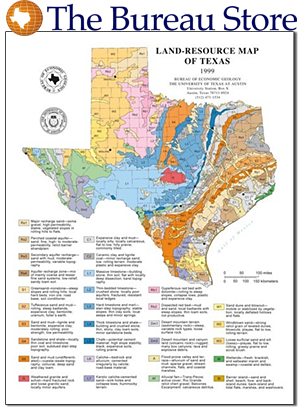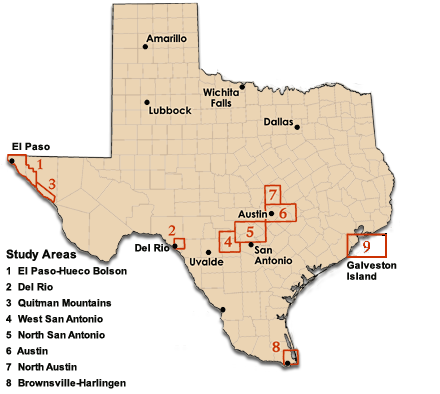Geologic Mapping
You are invited to participate in a national assessment of the economic benefits of geologic mapping coordinated by the Association of American State Geologists. To participate, copy and paste this link into your browser – https://www.surveygizmo.com/s3/5772757/e216571551c0. It directs you to an online questionnaire focusing on your use of geologic maps and associated reports, and their value to your business or activity.
Surface Geologic Mapping

The Bureau offers more than 400 geologic maps of numerous types and sizes. To find the map you're looking for at The Bureau Store, click here.
Maps illustrating interpretations of the earth’s surface geology and related derivative maps, cross sections, stratigraphic columns and geologic descriptions are some of the Bureau’s traditional geologic products that are provided to the public. These geologic map products are typically used by professionals in geology, hydrology, engineering, urban planning, archeology, biology, and related fields, as well as policy makers, teachers, students, and laypersons. Management of water resources, land-use planning, identification of sources of earth resources such as sand and aggregate, recognition of areas prone to foundation problems, and evaluating changes in sensitive coastal environments are a few examples of the many uses of geologic maps.
Mapping of the surface geology in Texas is being done to provide a geologic map database and related basic geologic framework information that is sufficiently detailed (1:24,000 to 1:100,000) to serve as a primary data source for applied earth science investigations. Maps constructed during recent years address a variety of needs, including (1) planning and managing land use for sensitive coastal environments, transportation/population corridors, and areas of major construction/engineering projects; (2) studying erosion, sedimentation, and habitat changes of coastal environments; (3) evaluating and developing earth and mineral resources; (4) studying aquifer recharge; (5) evaluating land use and potential earth resources of unconventional shale oil and gas exploration/production areas; and (6) studying Texas geologic hazards. Bureau geologic mapping projects include the STATEMAP program, which is part of the National Cooperative Geologic Mapping Program administered by the U.S. Geological Survey, and a component of the Bureau’s STARR program that deals with mapping and studying mineral and earth resources and geologic hazards.
Bureau geologic mapping projects include the STATEMAP program, which is part of the National Cooperative Geologic Mapping Program administered by the U.S. Geological Survey, and a component of the Bureau’s STARR program that deals with mapping and studying mineral and earth resources and geologic hazards. Texas agencies contribute to the process of identifying and prioritizing geologic map study areas during annual meetings with scientists and managers of the Texas Water Development Board, General Land Office of Texas, Texas Railroad Commission, Texas Parks and Wildlife Department, Texas Commission of Environmental Quality, and Texas Natural Resources Information System, and with scientists of Federal agencies such as the U.S. Geological Survey and the U.S. Fish and Wildlife Service. Long term goals for geologic mapping in Texas include baseline map data along the Texas Gulf Coastal Plain Corridor where there are some areas of environmental concerns such as erosion, flooding, loss of sensitive coastal environments, maps to help foster economic development of minerals/earth materials and manage potential geologic hazards, and detailed geologic maps within population/transportation corridors where population increase and rapid urban/suburban development is causing increased demands on earth resources and groundwater. Researchers involved with Bureau geologic mapping projects are Eddie Collins, Brent Elliott, Jeff Paine, Chock Woodruff, Tiffany Caudle, and John Andrews. Geologic maps are available through the BEG publications store. Open-file digital map data sets for some of the peer reviewed maps may be found below in the GIS Databases section of this page.
Subsurface Mapping of Groundwater Horizons: Surface Casing Estimator Site
The Surface Casing Estimator Site, also often referred to as the Estimator Site, is a website that provides estimates of the depths to groundwater horizons that may require borehole casing for groundwater protection. This project is funded by the Railroad Commission of Texas (RRC) and coordinated by the Commission’s Groundwater Advisory Unit. A goal of the website is to provide Industry operators the ability to obtain relatively quick estimates of depths for groundwater horizons that can be used to help plan wells and obtain a surface casing letter from the RRC. It is important to note that Estimator Site values are not final regulatory values. The RRC Groundwater Advisory Unit determines and provides final recommendations for groundwater protection in required Surface Casing Letters. Another goal of the project is to scan the paper copy geophysical logs of the Groundwater Advisory Unit’s vast Q-log library so that these data are preserved as digital tiff images and have a representative number of Q-logs available for viewing on the Estimator Site.
In addition to Industry operators, other professionals interested in groundwater may also receive useful information from the Estimator Site. The site provides estimates on elevations and depths for the top and base of fresh water (1,000 tds), base of usable-quality water (3,000 tds), base of underground source of drinking water (10,000 tds), and top and base of some water-bearing stratigraphic units. Other information provided by the site includes general aquifer names, geophysical logs, and well locations. The estimator site currently provides information for 65 Texas counties. More than 8,500 geophysical logs can be viewed on the website. Bureau researchers on this project are Eddie Collins, Aaron Averett, and Jeremy Ortuno.
STATEMAP GIS Databases

This directory contains various GIS databases that were created for Bureau STATEMAP research projects. Specific information for each database is in the metadata in the zipped file.
All databases are zipped shapefiles in ArcView shapefile format.You must have ArcView software to view the databases. The datasets cannot be viewed with any other imaging software or with a web browser. Download ArcExplorer software from this site: ESRI.
Most are in the UTM projection with either NAD27 or NAD83 datums.
Please consult the associated metadata and readme files contained within the individual database zip file for specific information.
For further information refer to the source publication.
- Geology of the Austin area; 1:62,500 scale [area 6 on map] [zip]
- Geology of the Austin West Quadrangle; 1:24,000 scale [area 6 on map] [zip]
- Geology of the Del Rio area; 1:24,000 scale [area 2 on map] [zip]
- Geology of the Georgetown area; 1:24,000 scale [area 7 on map] [zip]
- Geology of the Hueco Bolson; 1:24,000 scale [area 1 on map] [zip]
- Geology of the Southern Quitman Mts.; 1:125,000 scale [area 3 on map] [zip]
- Wetlands map from the Submerged Lands of Texas, Brownsville-Harlingen; 1:125,000 scale [area 8 on map] [zip]
- Geology of the New Braunfels area; 1:24,000 scale [area 4 and 5 on map] [zip]
- Geoenvironments of Galveston Island; 1:24,000 scale [area 9 on map] [zip]
- Geoenvironments of Christmas Point Quadrangle; 1:24,000 scale [area 9 on map] [zip]
- Geologic Map Of The Southeast Part Of The Austin, Texas, 30 x 60 Minute Quadrangle: Central Texas Population Corridor Encompassing Bastrop and Smithville; 1:100,000 scale [zip]